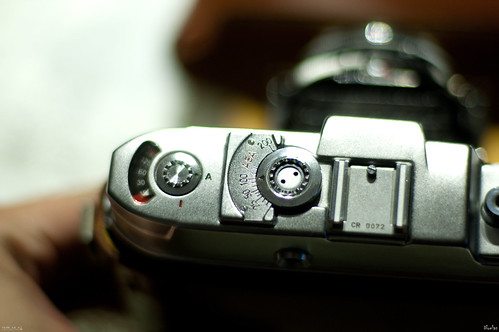Difference between revisions of "Automatic 66"
m (typo) |
(Removed repeated details. Moved floated picture back to the top. Other minor changes.) |
||
| Line 1: | Line 1: | ||
| − | |||
| − | |||
| − | |||
<div class="floatright plainlinks" style="margin:0px 0px 10px 15px;"> | <div class="floatright plainlinks" style="margin:0px 0px 10px 15px;"> | ||
{{Flickr_image | {{Flickr_image | ||
| Line 12: | Line 9: | ||
}} | }} | ||
</div> | </div> | ||
| + | The '''Automatic 66''' is an innovative coupled-rangefinder camera for 2¼-inch square (6x6cm) pictures on [[120 film]], made by [[Agfa]] in 1956.<ref name=McK>{{McKeown12}} p17.</ref> It is a development of the [[Super Isolette]]. The camera provides [[aperture-priority]] auto-exposure by an ingenious part-electrical and part-pneumatic mechanism, based on a selenium light meter. | ||
| − | + | The lens is a unit focusing, multicoated 75 mm f/3.5 '''Color-Solinar''', which is a color-corrected version of Agfa's Tessar copy. The shutter is a [[Prontor]] SVA<ref name=McK></ref> ('A' presumably for Automatic) and gives manually-set speeds from 1 to 1/300 second, plus 'B' and the automatic 'A' setting. | |
| − | |||
| − | The lens is a unit focusing, multicoated | ||
The camera has a film advance knob (on the right) and an automatic frame counter (rather than a red window). | The camera has a film advance knob (on the right) and an automatic frame counter (rather than a red window). | ||
| − | + | ====Auto-exposure==== | |
| − | + | The film speed (set on the meter, in the top housing) and aperture controls both adjust variable resistances that bias the meter output. | |
| − | === | ||
| − | |||
| − | |||
In the user's manual, the meter's linkage to the shutter is compared to a cylinder air pump, with a spring-loaded piston, and a variable-diameter air inlet port.<ref name=CD>[http://www.club-daguerre.de/agfa-automatic-alt.htm Automatic 66] at [http://www.club-daguerre.de Club-Daguerre], including text (in German) quoted from the user's manual.</ref> The meter output determines the size of this air port, and the flow of air through it acts as an escapement mechanism, determining the delay before the shutter closes. The mechanism is in fact not Agfa's invention: it was the subject of a patent by the Italian firm [[Durst]].<ref>[http://worldwide.espacenet.com/publicationDetails/originalDocument?CC=DE&NR=923525C&KC=C&FT=D&date=19550214&DB=EPODOC&locale=en_EP German patent DE 923525 (C)], lodged 1952 and granted 1954 to Julius & Gilbert Durst; at [http://worldwide.espacenet.com/?locale=en_EP Espacenet], the Patent search facility of the European Patent Office.</ref> | In the user's manual, the meter's linkage to the shutter is compared to a cylinder air pump, with a spring-loaded piston, and a variable-diameter air inlet port.<ref name=CD>[http://www.club-daguerre.de/agfa-automatic-alt.htm Automatic 66] at [http://www.club-daguerre.de Club-Daguerre], including text (in German) quoted from the user's manual.</ref> The meter output determines the size of this air port, and the flow of air through it acts as an escapement mechanism, determining the delay before the shutter closes. The mechanism is in fact not Agfa's invention: it was the subject of a patent by the Italian firm [[Durst]].<ref>[http://worldwide.espacenet.com/publicationDetails/originalDocument?CC=DE&NR=923525C&KC=C&FT=D&date=19550214&DB=EPODOC&locale=en_EP German patent DE 923525 (C)], lodged 1952 and granted 1954 to Julius & Gilbert Durst; at [http://worldwide.espacenet.com/?locale=en_EP Espacenet], the Patent search facility of the European Patent Office.</ref> | ||
| + | The Automatic 66 was expensive (it sold for DM 498 in 1956) and rather few (less than 5000<ref name=CD></ref>) were made; it commands high prices. | ||
Revision as of 21:01, 29 December 2012

|
| Top housing of the Automatic 66, showing the meter image by Noelas (Image rights) |
The Automatic 66 is an innovative coupled-rangefinder camera for 2¼-inch square (6x6cm) pictures on 120 film, made by Agfa in 1956.[1] It is a development of the Super Isolette. The camera provides aperture-priority auto-exposure by an ingenious part-electrical and part-pneumatic mechanism, based on a selenium light meter.
The lens is a unit focusing, multicoated 75 mm f/3.5 Color-Solinar, which is a color-corrected version of Agfa's Tessar copy. The shutter is a Prontor SVA[1] ('A' presumably for Automatic) and gives manually-set speeds from 1 to 1/300 second, plus 'B' and the automatic 'A' setting.
The camera has a film advance knob (on the right) and an automatic frame counter (rather than a red window).
Auto-exposure
The film speed (set on the meter, in the top housing) and aperture controls both adjust variable resistances that bias the meter output. In the user's manual, the meter's linkage to the shutter is compared to a cylinder air pump, with a spring-loaded piston, and a variable-diameter air inlet port.[2] The meter output determines the size of this air port, and the flow of air through it acts as an escapement mechanism, determining the delay before the shutter closes. The mechanism is in fact not Agfa's invention: it was the subject of a patent by the Italian firm Durst.[3]
The Automatic 66 was expensive (it sold for DM 498 in 1956) and rather few (less than 5000[2]) were made; it commands high prices.
Notes
- ↑ 1.0 1.1 McKeown, James M. and Joan C. McKeown's Price Guide to Antique and Classic Cameras, 12th Edition, 2005-2006. USA, Centennial Photo Service, 2004. ISBN 0-931838-40-1 (hardcover). ISBN 0-931838-41-X (softcover). p17.
- ↑ 2.0 2.1 Automatic 66 at Club-Daguerre, including text (in German) quoted from the user's manual.
- ↑ German patent DE 923525 (C), lodged 1952 and granted 1954 to Julius & Gilbert Durst; at Espacenet, the Patent search facility of the European Patent Office.
Links
In English:
- Automatic 66 at Certo6.com.
- Automatic 66 in an auction in September 2006 by Auction Team Breker in Cologne.
- Automatic 66 sold at auction (for €900) at the November 2011 Westlicht Photographica Auction in Vienna; several excellent pictures.